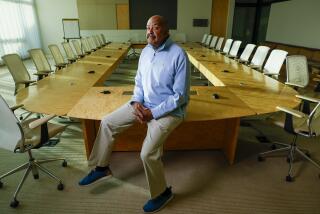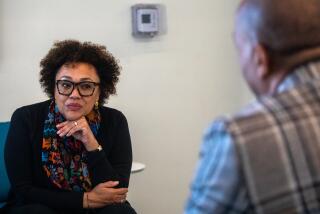His pitch for the arts has kept NEA alive
- Share via
From West 111th Street, Lennox’s Moffett Elementary School could be mistaken for an underground military weapons depot. A driveway passes through a gray metal fence, then curls up onto the paved roof of the building. At the southwest side, broad brick stairs funnel pedestrians to the school doors, and grassy earth is banked up against the southeast wall, forming yet another fortress in a neighborhood of bungalows behind forbidding fences and grated windows.
Dana Gioia, 56, grew up a few blocks from here in Hawthorne, and he has returned from Washington, D.C., for a few hours to do something he does well: sell.
Gioia, a highly regarded poet and former marketing manager for the desserts division of General Foods, is just a few weeks into his second term as chairman of the National Endowment for the Arts. “Jell-O Jigglers” was one of his big successes before he left the corporate life in 1992 to write full time, mostly poetry and music criticism.
Now Gioia sells the arts, a gig he says he initially didn’t want when first approached more than four years ago.
“I was a writer. I was very successful. I was living in California,” Gioia told about 40 people gathered for a grant-seeking workshop at Moffett, a site selected in part for its innovative arts-based education programs. “I had no interest in going into politics or going to Washington. But I saw a trend across the United States that scared me.”
The trend: the erosion of arts education from the nation’s public schools.
Though no one claims that Gioia has single-handedly reversed that course, he has had a profound effect on the NEA, converting the once-beleaguered federal program into the nation’s main engine for integrating arts and education.
It’s a remarkable turnaround for an agency whose mere name was once enough to get Newt Gingrich and other social conservatives foaming at the mouth. Controversial exhibits, including Robert Mapplethorpe’s homoerotic photographs and Andres Serrano’s picture of a plastic crucified Christ in a jar of urine, made the NEA the central battleground in the 1990s culture wars.
“The most important thing for the NEA was to bring it outside politics and to refuse the polarization that the critics had imposed on the agency,” Gioia said, sipping a Beck’s beer from a glass in a Marina del Rey hotel a few hours after his Moffett school appearance and visits to the Torrance Cultural Arts Center and L.A. Theatre Works.
For Madeline Puzo, dean of USC’s theater school and a former NEA consultant, the key questions raised by the assaults on the NEA remain unanswered.
“In a democracy, what is the role of the arts and what is the role of the government with the arts?” Puzo said. “There was support for the arts from those political and religious institutions. We haven’t figured that out.”
But she believes “one has to credit Dana Gioia for managing to not only help [the NEA] survive, but to grow a bit.”
A decade after Congress was on the verge of killing the agency, the NEA’s most recent budget was readily approved on a voice vote. “We let our critics dictate the public conversation about the arts endowment and government funding -- then you’re always reacting,” Gioia said about the earlier NEA controversies.
“It seemed to me that we had to take an active role in creating the public conversation that would lead to productive change in society. You don’t do this by venting opinions. You do this by figuring out what should be done, and what works.”
Stepping into the fray
When Gioia was drafted to take over the agency in 2003, the bullets were flying from all directions.
“Both the left and the right would have been happy for me to fail for different reasons,” Gioia said. “The right -- when I came to Washington, every month there were about 125 members of Congress who voted to abolish the NEA. They were constantly shooting warning shots across the bow. And I think the left would have loved to see any of the [Bush] administration’s efforts fail, just to prove that it wasn’t working.”
Gioia, taking Franklin D. Roosevelt’s Depression-era Works Progress Administration as his inspiration, decided to redirect the agency toward rebuilding the nation’s arts infrastructure by sponsoring research into arts and reading habits, and helping arts organizations become more integrated with and vital to their own communities while creating a broad consumer market for the arts.
He has conceived or backed such NEA innovations as sending theater and opera troupes to military bases; creating a national network of acting companies to perform Shakespeare to expose more people to the work and give actors jobs; helping support the Big Read, a program building on the trend of communities reading and discussing a single literary work; and sponsoring Poetry Out Loud, aimed at getting high schoolers to connect with poetry.
Less visibly, Gioia has ensured that the NEA awards at least one grant a year in each congressional district, under his belief that arts support should be spread as widely as possible.
“When I got there, 22% of the U.S. never got a grant,” Gioia said. “You’re talking about 70 million people.”
Spreading the grants around also has the politically pragmatic effect of giving the agency a support base in every congressional district.
“You’re in a lot better position to face controversy if you’ve got grants going to districts throughout the U.S.,” said Jonathan Katz, chief executive of the National Assembly of State Arts Agencies. “The context has been redefined.... You can have conversations [with congressional critics] and say, ‘Yeah, we fund the range. We fund what your folks and constituents have requested that we fund.’ ”
Still, such initiatives take their own large slices of the NEA’s shrunken pie.
“Expanding these kinds of programs could mean less money for other kinds of programs,” said Bob Lynch, president of the Americans for the Arts advocacy group. “Everything like that is a choice. His emphasis and his hope is to create a broader visibility for both the arts and the NEA,” which Gioia believes “translates into a broader consumer market.”
Though some of the turnaround began under one of Gioia’s predecessors, Bill Ivey (1998-2001), Gioia’s efforts to mend political fences in Washington and make the NEA more integral in promoting the arts across the nation has taken the NEA out of the social conservatives’ woodshed.
“He’s been pretty systematic in the way he’s gone about doing that,” said Doug McLellan, a Seattle-based arts writer and editor of ArtsJournal.com. “It’s no longer the political hot button it once was. That’s partly the changing political climate, but he has certainly contributed to it by making it an institution that’s difficult to argue with.”
The cost? A certain homogenization. “They’re not on the cutting edge,” McLellan said. The benefit? Even Democrats like him.
“I really think he’s a star in this administration,” Rep. Jane Harman (D-Venice), a harsh White House critic, said as she introduced Gioia to the grant seekers at Moffett Elementary this month.
Over the last four years, Gioia has overseen a fundamental change in the way the NEA works. The terms were dictated in part by the Republican-led Congress, which in 1996 effectively gutted the NEA with the acquiescence of the Clinton administration after Congress threatened to shutter the agency altogether. A budget that peaked at $175 million in 1992 was slashed to $99.5 million, and 40% of that was set aside as block grants for states. Direct grants to artists were eliminated.
Funding since then has slowly climbed to $124.4 million in the current fiscal year, and President Bush’s budget proposal sent to Congress recently would hike the budget to $128.4 million. Direct artist grants are still banned. Though private groups such as the Warhol Foundation have sought to try to pick up some of that slack, the net effect for the NEA was its removal from the battlefield of the culture wars.
“I don’t believe the arts are about right or left,” Gioia said. “If we want to create the communities we want to live in, and if we want our schools to produce the best educations for our children, we need the arts. This is not a partisan issue. This is civic common sense.”
More to Read
The biggest entertainment stories
Get our big stories about Hollywood, film, television, music, arts, culture and more right in your inbox as soon as they publish.
You may occasionally receive promotional content from the Los Angeles Times.











